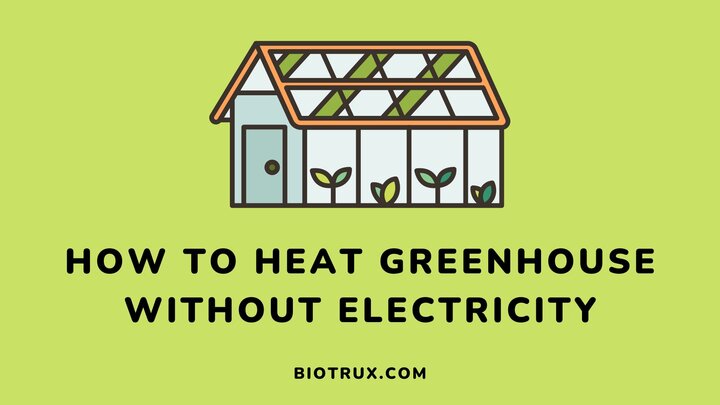There are several ways you can heat a greenhouse without electricity. How you execute most of these options will, however, rely heavily on the energy of the sun. While these methods will help you save money, you should not expect them to generate the same warmth as electric heating.
Aside from being budget-friendly, heating a greenhouse without electricity is not weather-restricting. In other words, combining different options is a great way to stay insured without electricity if your design is great.
This guide will help you with some of the best natural designs, whether you already have a greenhouse or are planning on building one.
How To Heat a Greenhouse Without Electricity

1. Hotbeds or composting pile
Creating a hotbed or a composting pile filled with manure, hay, vines or mulch can increase the heat in your greenhouse by 100°F or more if they are well arranged.
You should also turn them in regularly for better effectiveness. Hotbeds ideally do not take up space in greenhouses but if yours is small, try converting it to a planting area.
2. Use black water tanks or paints to absorb Heat
Black water tanks are also great for generating heat in a greenhouse especially when the sun is up. These tanks must be filled with water and must face north for this to work effectively.
Once they absorb heat, the water in them becomes warm and will keep your greenhouse warm during intense sunlight and when the sun goes down. Please note that the ideal recommendation for this procedure is 2.5 to 5 gallons of water per sqft.
3. Opt for double layers
Building a two-tiered greenhouse will aid in heat retention. An effective way to achieve this is to opt for twin-wall polycarbonate sheets that provide year-round insulation.
In cases where it is already cold outside and you past opting for double layers, bubble wrap can help cover the walls of your greenhouse and provide the needed insulation.
4. Make use of animal cages
A rabbit hutch or chicken coop is a very cheap way to heat your greenhouse without electricity. All you need to do is place these housings in pivotal locations.
If a chicken can generate about 10 watts of heat, how much heat do you think 20 chickens will generate for your greenhouse?
5. Seal gaps or openings
Your greenhouse may lose too much heat due to gaps or holes in its structure. Inspecting it regularly and sealing openings is another way to improve insulation.
6. Install humidifiers
Heat naturally increases with humidity. This is because humidity traps heat during the day and radiates it at night. You can install a humidifier in your greenhouse to amplify this natural phenomenon.
This device will be a constant catalyst for keeping your plant house warm without electricity, especially at night.
7. Go underground
If you are on the verge of building a greenhouse and don’t want electric heating to be your primary source, you should consider building your greenhouse below ground.
An underground greenhouse is excellent to keep your plants warm without electricity. This is because such greenhouses won’t be exposed to the temperature outside.
Grow lights will also provide the light your plants need to grow. Fortunately, they are budget-friendly.
8. Black Paints
The use of black paint follows a similar principle to water tanks. All you need to do here is paint the walls of your plant house black and let it absorb sunlight and spread heat.
FAQs
What is the most efficient way to heat a greenhouse?
Electric heating remains the most efficient way to heat a greenhouse because they do not emit extra moisture into the atmosphere like paraffin or propane heating systems.
This method spreads warmth evenly, reducing the possibility of cold spots in your greenhouse.
What is an example of a passive heating system?
An example of a passive heating system is using stone, concrete, or water to store and distribute heat.
These materials are called thermal masses because of their superb heat capacities.
What holds heat inside a greenhouse?
Plastic or glass in a greenhouse’s walls helps absorb heat, raise the temperature of the plant house, and keep warm air from escaping.
Wrapping Up
There you have it—the different ways you can heat your greenhouse without electricity. While electric heating is one of the easiest and most efficient ways to get this done, having one or two backup plans is not a bad idea.
Choosing which method works best for you depends on the location of your greenhouse or where you plan on setting it up.
You also don’t have to stick to just one method, you can combine them to ensure your greenhouse is not susceptible to a particular weather.
I hope you found this guide helpful. Have you ever imagined our ultra-digital world without electricity? See what will happen to the earth without electricity.
Thanks for reading.

